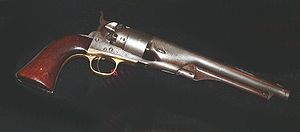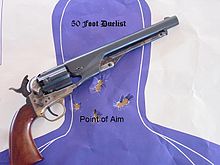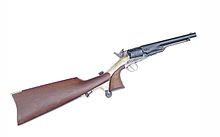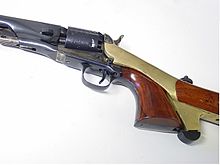- Colt Army Model 1860
-
Colt Army Model 1860 
Colt Army Model 1860Type Revolver Place of origin  United States
United StatesService history Wars American Civil War Indian Wars
Production history Designer Samuel Colt Manufacturer Colt's Manufacturing Company Produced 1860 to 1873 Number built over 200,000 Specifications Weight 43 oz (1219 g) Length 14 in (355.6 mm) Barrel length 8 in (203.2 mm) Height 5.25 in (133.35) Cartridge Paper-wrapped .44 caliber round and conical ball (paper cartridge) Caliber .44 Action Percussion Muzzle velocity 550-1000 ft/s Effective range 75-100 yds (68.5 - 91.4 m) Feed system 6 round cylinder The Colt Army Model 1860 is a muzzle-loaded cap & ball .44-caliber revolver used during the American Civil War, made by Colt's Manufacturing Company. It was used as a side arm by cavalry, infantry, artillery troops, and naval forces.
The Colt 1860 Army uses the same size frame as the .36 caliber 1851 Navy revolver. The frame is relieved to allow the use of a rebated cylinder that enables the Army to be chambered in .44 caliber. Also, the barrel on the 1860 Army has a forcing cone that is visibly shorter than that of the 1851 Navy, allowing the Army revolver to have a longer cylinder. A major distinguishing feature of the Colt 1860 Army first introduced on the M1855 Colt Root revolver was the "creeping" loading lever.
More than 200,000 were manufactured from 1860 through 1873. Colt's biggest customer was the US Government with over 127,000 units being purchased and issued to the troops. The weapon was a single-action, six-shot weapon accurate up to 75 to 100 yards, where the fixed sights were typically set when manufactured. The rear sight was a notch in the hammer, clearly visible only when the revolver was cocked.
The Colt .44-caliber “Army" Model was one of the most widely-used revolvers of the Civil War. It had a six-shot, rotating cylinder, and fired a 0.454-inch-diameter (11.5 mm) round lead ball, or a conical projectile, that was propelled by a 30 grain charge of black powder ignited by a copper percussion cap that contained a volatile charge of fulminate of mercury (a substance that explodes upon impact). The percussion cap, when struck by the hammer, ignited the powder charge. When fired, balls had a muzzle velocity of about 900 feet per second.
Contents
Variations
There are very few variations on the 1860 Army Revolver, but there was limited production of a 7.5-inch barrel model.(Wilson 1985), and a lightened model with cylinder flutes. According to importer Cimarron Arms Company, this was called the "Texas Model" because a number of them came into Texas shortly after secession. The goal was to make use of silver spring steel of controlled carbon content and greater strength, but the thinned cylinder proved inadequate and sometimes exploded.(ibid wilson)
Military 1860s had elongated screw lugs on the side of the frame to mount a detachable shoulder stock.
Original Colt Army Model 1860 revolvers had steel frames. Modern replicas are made by many manufacturers, some of which have steel frames and some of which have brass frames. Brass frame replicas are intended for use with lighter loads than the 30 grains of FFFg powder that may be used with modern day steel frame replicas, typically ranging from approximately 12 to 15 grains up to 20 grains of FFFg powder.
Operation
Loading is a somewhat lengthy process, with each of the six chambers drilled into the revolving cylinder being loaded from the front, or "muzzle" end. A measured amount of black powder is poured into a chamber. Next a lead ball is placed at the opening of the chamber and seated by firmly pressing it in with the pivoting loading lever which is attached beneath the barrel of the revolver. For sealing each chamber, an over-size 0.454-inch-diameter (11.5 mm) lead ball is trimmed slightly by the loading ram to enter the chamber. Also, as well as for many 19th Century civilian shooters, modern shooters often place a lubricated wad between balls and powder, or, alternatively, pack lard or a commercially-sold bore lubricant at the mouth of each chamber to prevent powder in one chamber from being ignited when another is fired, which is known as a chainfire.
When the Colt Model 1860 was used by 19th century soldiers, they most often loaded the gun using paper cartridges. These cartridges consisted of a pre-measured load of black powder and a ball, wrapped in nitrated paper (paper that had been soaked in potassium nitrate and then dried, to make it more flammable). To load each chamber, one only had to slip the cartridge into the front of the chamber and seat the ball with the loading lever ram. Then a percussion cap was placed onto the raised aperture, called a nipple, at the back end of the chamber.
The Colt 1860 cost approximately $20 per revolver. This was rather expensive during the 1860s, both for the United States Army and private citizens.
The Colt "Army" revolver is to be distinguished from the Colt "Navy" revolver of which there were two models, the octagonal barrel Model 1851 Navy, and the round-barreled Model 1861 Navy, both Navy models being in the smaller .36-caliber. Replica Navy revolvers sold today are often sold in the historically-incorrect .44-caliber; originally, all Navy revolvers were only manufactured in .36-caliber.
References
- Kirst, W.J. (1983). Self Consuming Paper Cartridges for the Percussion Revolver. Minneapolis, Minnesota: Northwest Development Co..
- Wilson, R.L (1985). Colt, An American Legend. New York, London: Atabras, A Division of Abbeville Publishing Group. THE 1860 Army was loaded with a Conical Lead Bullet or Round Ball. Soldiers were issued paper cartridges that were loaded with a Conical Bullet.
See also
- Colt 1851 Navy Revolver
- Colt M1861 Navy
- Colt's Manufacturing Company
- Paper cartridge
- Saturday night special for history of attempts to ban handguns other than Army and Navy models such as M1860 Army
External link
Categories:- Colt's Manufacturing Company
- Colt revolvers
- American Civil War weapons
Wikimedia Foundation. 2010.




